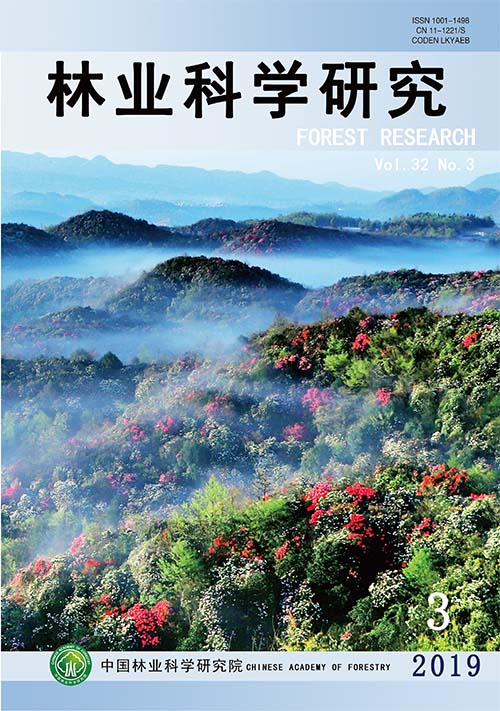-
DNA条形码(DNA barcoding)是一种基于DNA序列进行物种鉴定的新工具,它最早由加拿大科学家Paul Hebert于2003年提出,它是利用生物体内普遍存在的一个或几个、较短的且标准化的基因片段作为通用条形码,通过碱基序列差异来实现物种水平上的快速准确鉴定[1]。与传统形态分类相比,DNA条形码技术具有诸多显著优点,使其成为一项全新的物种分类和鉴定技术。1)DNA条形码是基于DNA水平的物种鉴定,它不因个体外部形态、发育阶段和环境变化而改变,扩大了样品检测范围;2)通过构建信息完善的标准数字化数据库,DNA条形码克服了传统分类的缺陷,提高物种鉴定成功率,同时有助于检测鉴定中可能存在的问题以及发现未知种;3)DNA条形码技术操作流程简单、规范,能突破对经验的过渡依赖,使物种鉴定大众化。
经过15年的发展,DNA条形码已成为生物领域发展最迅猛的研究方向之一。一方面,DNA条形码的兴起为传统经典分类的发展提供了机遇,极大推动了分类修订、新种和隐种发现,提高全球生物分类与鉴定速度[2-3]。同时,DNA条形码的发展也为生态学、进化生物学研究注入新的活力,为多学科融合开辟了路径,增强了人类对生物多样性监测和利用的能力[4-6]。另一方面,随着条形码技术的不断发展和标准数据库的不断完善,DNA条形码在对特殊材料的鉴定上展示了强大的实用价值,该技术已成功应用在海关、中药材真伪鉴定、法医鉴定、动植物检疫、生物入侵、食品和药物市场监督等诸多领域[7-10]。
DNA条形码为生物多样性管理、保护和可持续利用提供新的思路和研究工具。本文将介绍DNA条形码在近15年来的研究进展及其发展趋势,并阐述DNA条形码在林业科学研究各个领域的已有成果,深入挖掘DNA条形码在林业上的应用潜力,推动林业产业的发展。
HTML
-
作为一种快速鉴定物种的新工具,DNA条形码一经问世就得到了科技界和社会组织的积极响应和大力支持。2004年,Sloan基因在华盛顿史密斯尼国家自然历史博物馆(Smithsonian)成立了生命条形码联盟(Consortium for the Barcode of Life, CBOL)。该组织致力于发展鉴定生物物种的全球标准,积极推动条形码技术的发展和应用。2005年2月,由CBOL和英国自然历史博物馆主办的生命条形码协会第一次国际会议在伦敦召开,讨论决定建立全球条形码数据库,随后每隔两年召开一次国际条形码大会,分别于2007年、2009年、2011年、2013年、2015年、2017年在台北、墨西哥、阿德拉德、昆明、圭尔夫、南非等城市举办,吸引了全球近百个国家和地区的专家学者参加。DNA条形码相关研究发展迅速,论文发表连年增加,截止2018年9月,以DNA barcoding为关键词在Web of Science数据库进行检索,论文数量已达到11 488篇。
DNA条形码概念提出后,对标准条形码的确立一度成为研究热点。在生物体中找到简短(方便测序)、相对保守(引物通用性高)、且存在足够变异(区分不同物种)的DNA条形码片段并非一件容易的工作。2003年,Hebert教授提出将线粒体基因细胞色素C氧化酶亚基Ⅰ(cytochrome C oxidase subunitⅠ, COⅠ)作为动物DNA条形码[1]。此后的研究证实,该基因在动物各类群中表现良好,特别适用于昆虫、鸟类和鱼类等物种鉴定[11]。由于植物线粒体进化较慢,且植物类群间常存在杂交、多倍化或基因渐渗等复杂的进化历史事件,因此,植物中很难找到单一的通用条形码,研究远滞后于动物。科学家们经过约10年的探索与大量数据验证,最终确定将叶绿体基因rbcL、matK、间隔基因trnH-psbA、核糖体基因及其转录间隔区ITS/ITS2作为植物通用DNA条形码,但同时指出,因不同类群进化历史不同,应采用不同的片段组合提高物种分辨率[5, 12-14]。在真菌研究领域,核基因ITS被推荐作为核心DNA条形码[15]。
为实现对物种快速鉴定,构建标准化数据库是DNA条形码研究的核心和重要技术支撑。一个全面、标准和准确的DNA条形码数据库,必须保证数据库中DNA序列均来自分类学家可靠鉴定的标本,并具有详尽的注释和可靠的保存,且DNA序列正确,从而确定分子鉴定的可靠性[16]。早在2010年,世界上最大的生物多样性研究——国际生命条形码计划(International Barcode of life, iBOL)启动,计划构建全球范围内共享的动物、植物、真菌和原生生物等真核生命条形码数据库(the Barcode of Life Data System, BOLD)。除提交DNA条形码数据外,BOLD还要求操作者同时提交以下信息:标本图片、凭证标本信息、采集号、标本鉴定人、PCR扩增所用引物、测序原始峰图等。目前,在全球250个国家或地区的合作下,该数据库已完成近28万个物种,618万份标本的DNA条形码测序工作。其中,以鸟类、昆虫、鱼类等动物条形码数据为主,占68.68%,数据库技术服务(如物种鉴定和分类)也以COI基因为主;植物条形码数据占23.84%,真菌等其他微生物条形码数据占7.5%。此外,针对不同的研究对象和内容,一些国际组织构建了有关不同生物类群研究组或数据库,例如,真菌条形码研究组(http://www.fungalbarcoding.org),欧洲生命条形码联盟(http://www.ecbol.org/),鱼类生命条形码行动(http://www.fishbol.org/),鳞翅目类生命条形码(http://lepbarcoding.org/),毛翅目生命条形码(http://trichopterabol.org/),哺乳类生命条形码行动(http://www.mammaliabol.org/),海洋生命条形码(http://www.marinebarcoding.org/),检验检疫生命条形码(http://www.qbol.org/en/qbol.htm),海绵动物生命条形码(http://www.spongebarcoding.org),鸟类生命条形码(http://www/barcodingbirds.org/)等。
作为iBOL计划的4个中心节点之一,中国在推动DNA条形码技术的发展中作出了巨大贡献,特别在植物条形码领域。通过大量数据分析,中国科学家们推荐将ITS作为植物条形码的核心片段,并提出适合植物条形码研究的技术标准和规范[13, 17]。2012年,中国科学院昆明植物所主导启动新一代智能植物志(iFlora)研究计划[18]。该计划以中国电子植物志为基础,融合DNA条形码数据、新一代测序技术、地理信息数据和计算机技术等元素,实现物种快速准确鉴定和信息共享的数字化平台(http://www.iflora.cn/)。目前(截至2018年9月),iFlora已积累约300个科3 434个属39 971种物种的核心数据,并发布“中国常见植物DNA条形码数据库”、“国家重点保护野生植物DNA条形码数据库”和“中国药典药用植物DNA条形码数据库”3个专题数据库。中国也是BOLD中提交植物条形码数据最多的国家和地区。此外,在中药材方面,中国医学科学院建立了中药材DNA条形码鉴定系统(http://www.tcmbarcode.cn/china/), 香港中文大学构建了药材DNA条形码数据库(http://www.cuhk.edu.hk/icm/mmdbd.htm)。
-
条形码发展至今,筛选标准DNA条形码片段的工作已告一段落。近年来,提高鉴定物种和发现新种的能力是DNA条形码研究的主要工作之一。目前,研究主要分为两大类,一是基于特定科属的DNA条形码研究,即对精细类群构建条形码参考数据库,分析和评价条形码鉴定能力;二是基于区域范围内的DNA条形码研究,即对某一区域的物种开展生物多样性调查,评价DNA条形码在区域范围内的表现。
动物条形码COI基因被认为能区分95%的已知物种,但对一些类群的姐妹种或生态地理形态种的鉴定率较低[19-21]。植物DNA条形码,对不同类群的鉴定成功率存在显著差异,特别对快速分化类群的鉴定能力有限。这是由于一些类群进化速率较快,近缘物种的分化时间较短,尚未在种水平上累积一定的碱基序列差异,无法利用DNA条形码片段加以区分,如被子植物中快速分化类群报春花属(Primula L.)、杜鹃花属(Rhododendron L.)、龙胆属(Gentiana L.)、乌头属(Aconitum L.)等[22-25]。针对物种鉴定率低的问题,一些学者建议增加变异较大的基因来提高物种分辨能力,例如,动物DNA条形码研究者试图筛选适合的核基因作为特殊条形码来鉴定姐妹种[19]。此外,随着高通量测序技术的发展、测序成本的降低以及生物信息数据处理技术的提高,利用全基因组所包含的序列信息,被证实可以用来区分近缘种[26]。例如,植物的叶绿体全基因组序列信息量包含了足够多的变异,能提升对近缘类群的鉴定能力,可以作为植物条形码使用。近年来,基于第2代测序的基因组浅层分析技术能实现大批量、高效率、低成本地产生大量的短序列,再通过生物信息学分析处理,从而获取可靠的叶绿体基因组组装数据[5]。这使得该技术能被大多数生物学实验室所掌握,极大加速了它在植物DNA条形码上的应用。
区域DNA条形码研究,一般以生物多样性热点地区、自然保护区或大型固定样地为研究对象,利用DNA条形码数据和标准化研究体系,快速构建区域标准条形码数据库。目前,已在热带雨林巴拿马Barro Colorado Island (BCI) 50 hm2大样地[4]、波多黎各16 hm2大样地[27]、中国西双版纳自然保护区[28],亚热带森林鼎湖山自然保护区[29],北温带森林加拿大Churchill地区[30]、英国威尔士岛[31]等地区开展条形码研究。诸多研究均已证实DNA条形码在区域内鉴定未知物种的可行性,现已成为生物多样性快速评估的新工具。此外,区域DNA条形码与生态学、进化生物学、生物地理学等多学科结合,大尺度、跨区域研究生物学基础问题,开拓了群落系统发育学[32]和系统发育区系学[6]等新的研究方向,促进了生物多样性相关研究领域的发展和应用。
作为物种鉴定的新兴工具,DNA条形码对于非标准化材料的鉴定,有着传统物种鉴定方法无法媲美的优势。这一优势在中药材鉴定研究领域表现尤为突出。针对经特殊处理(晾晒、烘干、破碎等过程)的中药材,研究者从DNA的有效提取、适合中药材鉴定的标准条形码片段的筛选、鉴定方法的改进、药用植物标准DNA条形码数据库的构建等方面展开了深入研究,目前已形成较为完善的中药材DNA条形码鉴别体系,并在中药基原物种鉴定、道地药材鉴别、中药材溯源系统等方向取得一定的研究成果[33]。DNA条形码技术已成为现代中药材鉴定的未来发展趋势和必经之路。此外,对混合样品的鉴定也是当前DNA条形码作为物种鉴定工具的研究热点。第2代高通量测序技术的发展和普及,使得从复杂混合样品中获得大量DNA条形码序列成为可能。借助生物信息学手段分析,经与标准的DNA条形码数字化数据库进行比对,可以实现对物种的快速准确鉴定,该方法即为DNA meta barcoding技术。该技术能完全摆脱对分类经验的依赖,在环境生物多样性监测、动物的食谱、昆虫传粉网络、药剂饮品真伪检测、食品健康安全等多个研究领域应用成功[26, 34-36]。
-
准确的木材识别是禁止非法砍伐和保护森林资源的重要基础,也是规范木材贸易市场和保护珍贵濒危木材资源的关键技术支撑。传统的木材识别技术主要以木材解剖学为基础,通过识别木材宏观形态和微观解剖特征来实现对木材的准确鉴定。它要求鉴定者必需具有木材识别的专业技术和丰富经验,且操作过程复杂,一般人难以胜任。然而,其鉴定结果并不理想,只能区分科、属类别,很难达到种水平鉴定。DNA条形码技术凭借操作简单、不受个体形态特征限制、鉴定结果准确可靠等优势,为木材识别研究领域带来了曙光,具有广阔的应用前景。焦立超[37]研究DNA条形码对濒危木材的识别,发现trnL-F和ITS1能有效鉴别白木香(Aquilaria sinensis (Lour.) Gilg)木材,rbcL和ITS组合适用于区分胡杨(Populus euphratica Oliv.)木材,短片段trnL基因对微凹黄檀(Dalbergia retusa Hemsl.)、危地马拉黄檀(Dalbergia tucurensis Donn.Sm.)和交趾黄檀(Dalbergia cochinchinensis Pierre.)的鉴定效果明显,研究证实DNA条形码技术可以实现木材种水平的准确识别。余敏[38]证实DNA条形码trnH-psbA在近缘物种降香黄檀(Dalbergia odorifera T. Chen)和越南黄檀(Dalbergia tonkinensis Prain.)木材间存在明显的种间遗传距离,具有最高鉴别能力。Jiao等[39]评价条形码对紫檀属(Pterocarpus Jacq.)6个商用木材物种的标本和新鲜叶片材料的鉴定能力,结果显示ITS2+matK+ndhF-rpl32在木材鉴定中表现最佳,并强调构建木材标本DNA条形码数据库对木材识别和濒危木材保护的重要性。
目前,应用DNA条形码的主要挑战在于木材高质量DNA的提取和条形码片段的有效扩增。近年来,研究者从改进试剂盒法、木材径向位置、木材存储时间和木材干燥处理温度对DNA提取的影响等方向,在一定程度上能获得较高质量的木材DNA[40]。然而,由于木材在干燥过程中,受到水解反应、氧化反应以及微生物分解等作用,DNA片段易被降解为小片段分子,极其不利于整段条形码的扩增。针对不同树种及不同存储状况的木材,选用不同类型和长度的DNA片段,已成为DNA条形码技术在木材识别领域应用的“权宜之策”,严重限制了其发展和应用。然而,对同样经高温、干燥等高强度工业加工的中药材,DNA条形码在其鉴定领域发展迅猛。研究者推荐短片段ITS2(约300bp)作为中药材鉴定的标准条形码,构建药用植物标准DNA条形码数据库,使其成为中药鉴定的重要补充,加快了中药材鉴定标准化的进程,推动现代中药行业的发展[10]。因此,未来DNA条形码在木材识别领域,或许可以借鉴中药材鉴定条形码研究模式,尽快筛选适合木材DNA扩增的标准条形码短片段,构建木材标本DNA条形码数据库,最终实现DNA条形码在木材识别中的自动化和标准化。
-
从系统发育角度评价和探讨生物多样性形成和维持机制是群落生态学的热点话题。早期的群落系统发育分析,是通过基于APG分子系统构建群落系统发育树来评估群落物种间的系统发育关系。然而,由于大量物种在分子系统中缺乏DNA分子序列,导致由此构建的系统发育树存在多分歧分支,从而影响进一步分析[4, 27, 41]。这一现象在近缘类群较多的热带或亚热带森林中表现更为突出。DNA条形码数据库包含了群落中所有物种的DNA序列,其序列碱基差异可以被用来构建精确的群落系统发育树。Kress等[4]首次将植物DNA条形码rbcL、matK和trnH-psbA片段组合应用于巴拿马BCI 50 hm2热带雨林大样地的群落系统发育结构的研究。随后,Kress等[27]在波多黎各Luquillo 16 hm2样地、Pei等[41]在鼎湖山20 hm2亚热带森林大样地开展了类似研究。他们的研究均证实,利用DNA条形码序列所构建的系统发育树,能提供更为准确的分支末端类群的系统发育位置,并提升各分支节点的支持率,将更为真实地反应整个群落内所有物种的分支长度,从而避免因低精确度而引发统计错误。
经近10年发展,基于DNA条形码数据构建的群落系统发育树,结合群落生态学、进化生物学等理论,在计算系统发育多样性指数和探讨群落系统发育结构上提供了技术支撑,为评价生态因素(生境过滤、竞争排斥)与进化过程(物种分化、扩散和灭绝)对群落生物多样性形成和维持的影响,以及阐述系统发育地理区系形成等科学问题上发挥了巨大作用[5, 42]。目前,全球大型森林生态监测样地网络中,已有超过20个大样地完成了区域群落DNA条形码数据库的构建,极大地促进了网络样地平台生态学研究以及DNA条形码在群落生态学中的应用。我国鼎湖山20 hm2南亚热带常绿阔叶林大样地[41]、古田山20 hm2中亚热带常绿阔叶林大样地[43]、西双版纳20 hm2热带雨林大样地[28, 44]、哀牢山6 hm2中山湿性常绿阔叶林大样地[45]等先后构建木本植物DNA条形码数据库,并利用DNA条形码数据所构建的系统发育关系,探讨系统发育多样性指数选择、群落构建机制、负密度制约假说等科学问题,取得了不错的研究进展。
结合DNA条形码的植物群落系统发育研究多采用叶绿体片段rbcL+matK+trnH-psbA组合。核基因,由于进化速率快,变异较大,物种准确鉴定率高,特别对近缘类群的分辨能力强,已被成功应用在复杂类群和物种丰富度高的热带区域的DNA条形码研究中[28-29],但是在群落系统发育研究中鲜有报道。除考虑成本增加外,学者普遍认为ITS的进化历史复杂,存在多拷贝现象,导致测序成功率低,广泛应用的难度系数较大[46]。笔者在构建鼎湖山自然保护区木本植物DNA条形码数据库时发现,片段更短的ITS2,测序成功率更高,推荐将其作为亚热带常绿阔叶林的DNA条形码核心片段[29]。未来热带或亚热带群落系统发育研究可考虑补充ITS2序列数据,将更好地解决近缘类群的系统位置关系,估算分类单元间的分支长度,提高系统发育分析精确度。此外,Erickson等[47]利用全球15个森林生态监测样地的DNA条形码数据,重建了1 347个木本植物的宏系统发育树(mega-phylogeny),发现其精确度明显高于单个群落内的系统发育树。随着全球DNA条形码数据库的不断完善,核基因ITS或ITS2在越来越多的物种中被测序,条形码数据不断累积,有望能重建高精度的宏系统发育树。这将在生物低分类单元上具有更高的解决能力,由此提供不同区域群落系统发育关系,从而比较其群落系统发育结构。同时,也能在大尺度范围内探讨群落系统发育多样性或区系系统发育地理形成。这将帮助人类探讨生态过程和进化过程对群落共建的影响,更加深入的认识和了解全球生物多样性形成和维持机制。
-
DNA条形码作为物种快速鉴定的工具,在森林生物多样性监测和评估中扮演着非常重要的角色,其中标准DNA条形码数据库的构建是关键。在节肢动物、真菌、微生物等DNA条形码研究中发现,基于区域范围内的DNA条形码数据库对生物多样性调查、隐存新种发现具有非常实际的应用价值。例如,Bukowski等[48]研究南美洲大西洋森林中节肢动物多样性,通过一年内每周高频率密集采样,共采集了75 589份样本,分析这些样本的DNA条形码数据发现,它们代表 8 753个物种,而该地区利用传统调查方式获得的已知昆虫仅有358个物种,远低于条形码调查数据,其多样性水平长期被低估。D‘Souza & Hebert[49]利用DNA条形码技术,分析热带山地森林两个不同海拔样地中节肢动物种类时空动态变化,结果显示,在同一样地中不同年份间共有的节肢动物物种仅为9%~18%,不同样地间共存的物种数为10%,研究建议热带森林生物多样性调查应在大尺度下结合DNA条形码技术研究森林生物的时空变化,才能增强人类对生物多样性格局的认识。此外,基于高通量测序技术的DNA meta barcoding,结合区域DNA条形码数据库,能对幼苗、根尖、种子、虫卵、花粉粒等片段化材料进行准确鉴定,极大地提高DNA条形码在生物多样性研究领域的应用潜力。例如,Yoccoz等[50]研究土壤中的混合物,结合meta barcoding技术,实现对土壤中地上植物的鉴定;Ji等[51]利用metabarcoding技术在热带、亚热带和温带地区评估节肢动物、鸟类等类群的生物多样性,证实评估结果准确且可靠;Hawkins等[52]利用DNA metabarcoding鉴定蜜蜂携带花粉的来源,研究蜜蜂的访花偏好。
-
DNA条形码作为一种快速鉴定物种的工具,在林业科学研究领域带来了许多机遇,但是其应用潜能还有待进一步挖掘,在森林资源保护、种质资源调查和保存等研究方向缺少深入研究。我国是森林资源大国,第八次森林资源调查显示,全国森林面积2.08亿hm2,森林覆盖率21.63%,高等植物、动物、微生物等资源非常丰富。与此同时,伴随着人口的不断增加和社会经济飞速发展,对森林资源的需求不断增长,使得资源被过度开发利用、生境持续被破坏,越来越多的野生种质资源濒危或濒临灭绝,森林生物多样性受到严重破坏。因此,DNA条形码在以森林资源保护为前提的生态建设中有着广阔的应用前景。随着该技术的不断完善和相关研究的不断深入,DNA条形码技术在森林保护和资源可持续利用领域的研究和应用也将更加广泛。





 DownLoad:
DownLoad: